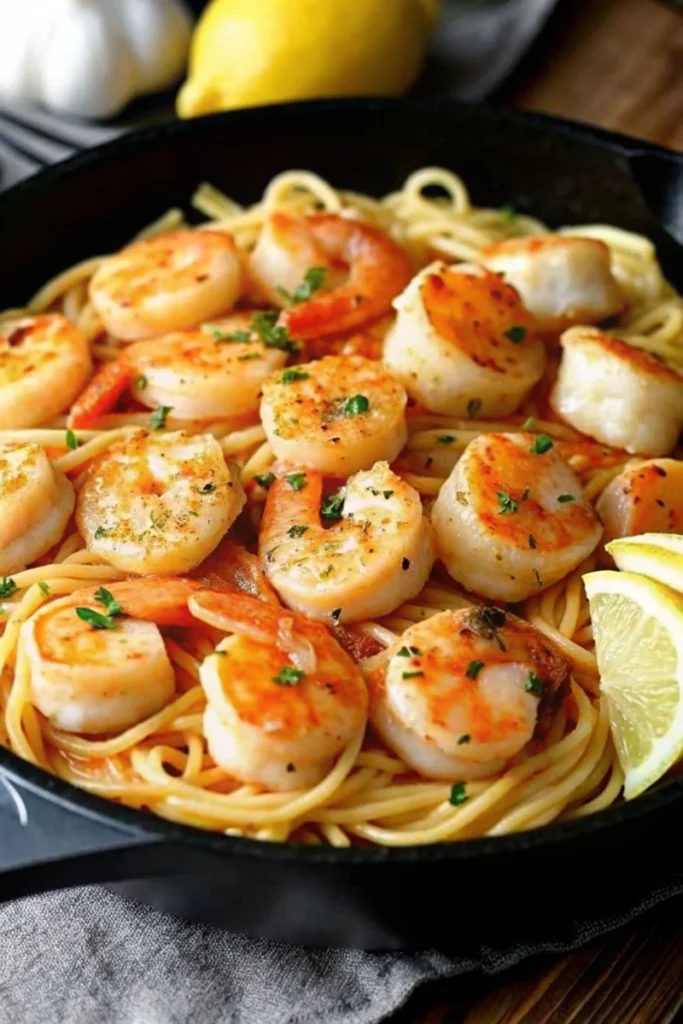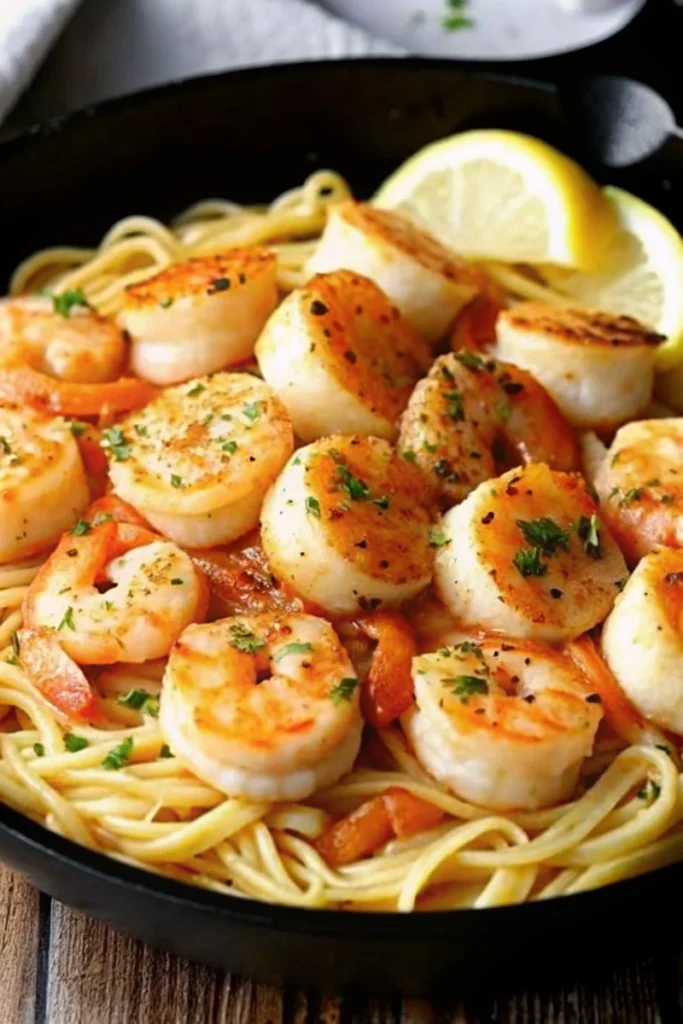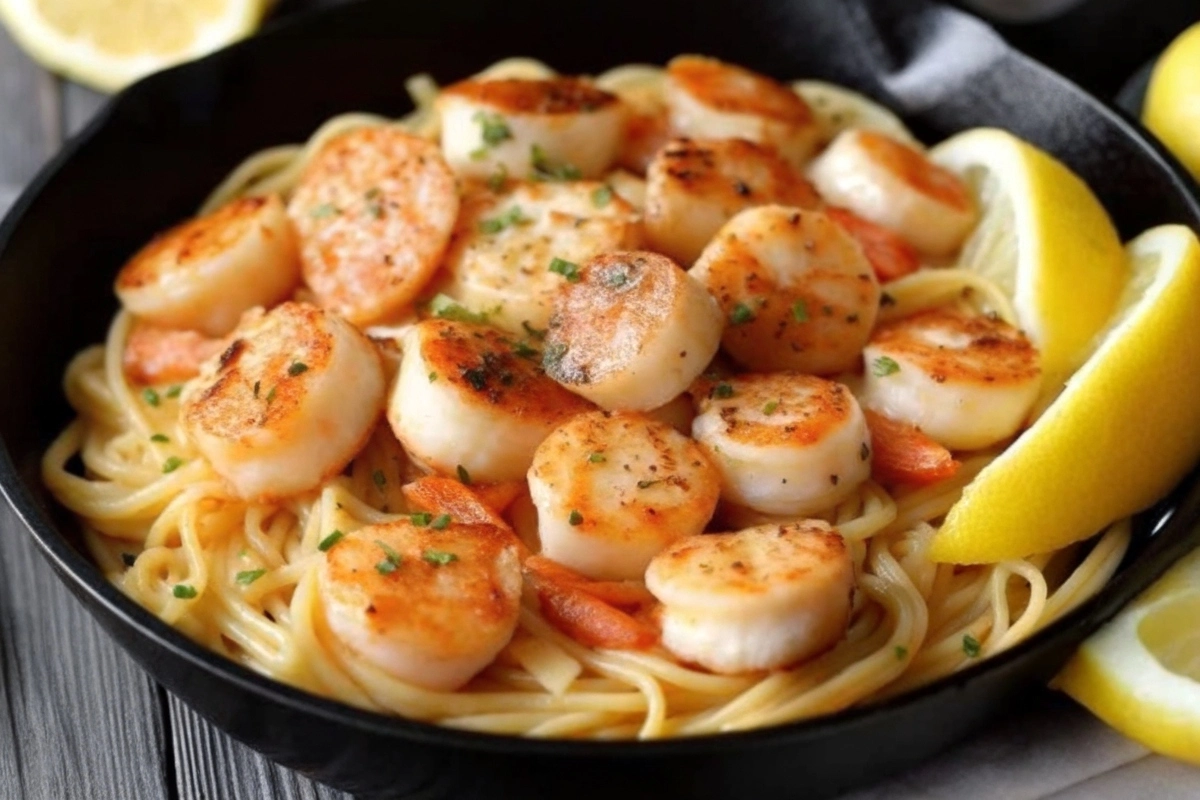Introduction to Garlic Butter Scallop and Shrimp Pasta
Imagine the sizzle of seared scallops meeting tender shrimp in a golden pool of garlic butter sauce, tossed with perfectly al dente pasta. Garlic Butter Scallop and Shrimp Pasta feels luxurious yet comes together in under 30 minutes. Whether impressing dinner guests or treating yourself after a long day, this seafood pasta delivers restaurant‑worthy flavors at home.
In this guide, you’ll learn every step, from sourcing top‑quality shellfish to balancing your sauce. We’ll explore:
- The origins of seafood pasta
- Why does this simple sauce work
- Expert tips for searing scallops without overcooking
- Secrets for emulsifying sauce with pasta water
- Variations to suit your taste
By the end, you’ll have all the tools to plate a dish that looks and tastes like a gourmet creation. Let’s dive into the world of garlic butter scallop and shrimp pasta and transform your next dinner into a culinary celebration.
What Is Garlic Butter Scallop and Shrimp Pasta?
Garlic Butter Scallop and Shrimp Pasta is a harmonious blend of sweet, tender shellfish and a rich, aromatic sauce served over long, silky noodles. The star ingredients are:
- Scallops: Seared to a golden crust
- Shrimp: Juicy and perfectly cooked
- Garlic Butter Sauce: A silky emulsion of melted butter, minced garlic, and bright accents like lemon zest and parsley
This dish shines because the sauce clings to every strand of pasta, coating each bite in buttery garlic goodness. For foolproof scallops, follow this detailed guide on How to Cook Scallops Perfectly Every Time to ensure a flawless sear without sticking or overcooking.
History and Origin of Seafood Pasta
Seafood pasta traces its roots to coastal regions of Italy, where fishermen’s bounty met simple pantry staples. In Liguria, the pesto‑strewn coast of northwestern Italy, shellfish often found their way into pasta dishes. Meanwhile, in Naples and Sicily, abundant shrimp and scallops were tossed with olive oil, garlic, and white wine, creating early versions of today’s beloved recipes.
The rise of garlic butter sauces came as chefs sought richer accompaniments to delicate shellfish flavors. Emulsifying pasta water with butter and garlic became a cornerstone technique, allowing home cooks to craft silky sauces without heavy creams. For a deep dive into the science of cooking pasta just right, see The Science of Cooking Pasta Al Dente.
Over time, chefs around the world added regional twists—fresh herbs in Provence, chili flakes in Spain, or cream in France—resulting in countless variations. Yet the core concept remains: highlight premium seafood with a bright, buttery sauce and perfectly cooked pasta.
Why This Recipe Works
The magic of garlic butter scallop and shrimp pasta comes from five key principles:
- High‑Heat Searing
- Locks in juices and creates a flavorful crust on scallops and shrimp.
- Emulsified Sauce
- Combining pasta water with melted butter creates a glossy, clingy sauce.
- Flavor Layering
- Garlic, shallots, white wine, and lemon zest build depth.
- Timing and Texture
- Cooking pasta to al dente ensures the perfect bite when mixed with seafood.
- Fresh Finish
- Parsley and red pepper flakes at the end add brightness and a hint of heat.
By respecting each step, especially the precise sear and the emulsification, you’ll achieve a cohesive dish where every forkful bursts with garlic‑buttery, ocean‑fresh flavor.
Ingredient Breakdown
Understanding each ingredient lets you make informed swaps and upgrades:
- Scallops
- Bay scallops are smaller; sea scallops offer more dramatic presentation.
- Pat them dry to ensure a golden sear.
- Shrimp
- Choose large, deveined shrimp with tails on for presentation.
- Rinse, pat dry, and season lightly.
- Pasta
- Linguine, spaghetti, or fettuccine work best—long shapes that capture sauce.
- Garlic & Aromatics
- Use fresh garlic, finely minced.
- Shallots add sweetness and complexity.
- Butter & Olive Oil
- A combination ensures high‑heat stability (olive oil) and rich flavor (butter).
- White Wine
- A dry white wine (Sauvignon Blanc or Pinot Grigio) deglazes the pan, lifting browned bits.
- Pasta Water
- Starchy water binds the sauce; reserve about ½ cup before draining.
- Seasonings
- Fresh parsley, lemon zest, and optional red pepper flakes for brightness and kick.

With these components, you can deliver a balanced dish, each element playing its role in flavor and texture.
Equipment and Tools Needed
Make prep and cooking seamless with the right tools:
- Large Pot for boiling pasta with ample water
- Heavy Skillet (preferably stainless steel or cast iron) for even heat and searing
- Tongs to handle pasta and seafood
- Slotted Spoon to transfer the scallops and shrimp
- Fine‑Mesh Strainer to reserve pasta water
- Microplane or Zester for lemon zest
Having everything at hand ensures a stress‑free cooking flow.
Sourcing Quality Seafood
Fresh seafood makes a world of difference:
- Fresh vs. Frozen
- Fresh scallops and shrimp near the seafood counter are ideal, but can be pricier.
- High‑quality frozen seafood—flash‑frozen at peak freshness—offers convenience and consistency.
- Selecting Scallops
- Look for a slightly sweet aroma and firm texture.
- Avoid scallops that appear slimy or have a strong “fishy” smell.
- Choosing Shrimp
- Opt for U/12 (under 12 shrimp per pound) for large presentation.
- Ensure shells are intact and eyes are clear if buying unpeeled.
- Handling and Storage
- Keep seafood on ice or in the coldest part of your refrigerator.
- Use within 24 hours of purchase for peak flavor.
By choosing top‑quality ingredients, you set the foundation for an unforgettable dish.
Choosing the Right Pasta
The pasta shape and cooking technique profoundly affect the final dish:
- Shape Matters
- Linguine and spaghetti: Classic choices that twirl beautifully.
- Fettuccine: Slightly wider, great for capturing sauce.
- Cooking to Al Dente
- Follow package instructions, but start checking a minute early.
- Bite should be tender with a slight chew.
- Reserving Pasta Water
- Always save about ½ cup of starchy water—essential for emulsifying the sauce.
- Draining and Timing
- Drain pasta just before it reaches the desired texture; finish cooking in the sauce to allow flavors to meld.
Mastering pasta technique ensures each strand carries that luscious garlic butter sauce.
Step‑by‑Step Cooking Process
1. Cooking the Pasta
- Bring a large pot of salted water to a rolling boil.
- Add pasta and stir immediately to prevent sticking.
- Cook until al dente—usually 1–2 minutes less than package directions.
- Reserve ½ cup pasta water, then drain and set pasta aside.
2. Building the Garlic Butter Sauce
- In your skillet, melt 2 tablespoons olive oil and 2 tablespoons unsalted butter over medium heat.
- Add 4 cloves of minced garlic and 1 finely chopped shallot.
- Sauté until fragrant and translucent (about 1–2 minutes), stirring constantly.
- Season with a pinch of red pepper flakes and freshly cracked black pepper.
3. Searing the Scallops
- Pat scallops completely dry—moisture is enemy #1 of a good sear.
- Increase heat to medium‑high and add 1 tablespoon olive oil.
- Place scallops in skillet, leaving space between each.
- Sear undisturbed for 1.5–2 minutes per side until a golden crust forms.
- Transfer to a plate and tent with foil.
4. Cooking the Shrimp
- In the same skillet, add a touch more butter if needed.
- Add seasoned shrimp, arranging in a single layer.
- Cook 1–2 minutes per side until pink and opaque.
- Remove shrimp and set aside with the scallops.
5. Deglazing with White Wine
- Pour ¼ cup dry white wine into the skillet to deglaze.
- Scrape up browned bits from the pan bottom—these carry intense flavor.
- Let the wine reduce by half (about 1–2 minutes).
6. Emulsifying the Sauce with Pasta Water
- Lower the heat to medium and whisk in 3 tablespoons cold butter, piece by piece.
- Add reserved pasta water gradually, whisking to form a smooth emulsion.
- Return scallops and shrimp to the pan.
- Add drained pasta and toss thoroughly, ensuring every strand is coated.
- Finish with lemon zest and chopped parsley before serving.

Variations and Customizations
Make this dish your own with simple tweaks:
- Creamy Version
- Stir in ¼ cup heavy cream after deglazing for a richer sauce.
- Herb Swaps
- Use fresh basil or tarragon instead of parsley for a new flavor profile.
- Heat Boost
- Add ½ teaspoon chili flakes or a dash of cayenne.
- Protein Twists
- Substitute lobster tails, clams, or mussels in place of scallops.
- Veggie Add‑Ins
- Toss in spinach or cherry tomatoes for color and texture.
These adjustments let you tailor the dish for special occasions or everyday enjoyment.
Serving Suggestions and Pairings
Elevate your meal with thoughtful pairings:
- Sides
- Crusty garlic bread or a simple green salad with lemon vinaigrette.
- Wine Matches
- A crisp Sauvignon Blanc, Pinot Grigio, or unoaked Chardonnay complements seafood.
- Presentation Tips
- Twirl pasta into nests on plates, top with scallops and shrimp, and garnish with parsley sprigs and lemon wedges.
A well‑paired side or glass of wine turns this pasta into a complete dining experience.
Storage and Make‑Ahead Tips
Planning? Keep your dish delicious:
- Refrigeration
- Store cooled pasta and seafood separately in airtight containers for up to 24 hours.
- Reheating
- Gently warm in a skillet with a splash of water or extra butter to revive the sauce.
- Freezing Components
- Prepare the sauce and pasta ahead (without seafood) and freeze; add fresh shellfish when reheating.
These strategies let you enjoy garlic butter scallops and shrimp pasta without last‑minute stress.
Troubleshooting Common Issues
- Rubbery Seafood
- Overcooking is the culprit—sear scallops and shrimp just until opaque and golden.
- Broken Sauce
- If the sauce separates, whisk in an extra tablespoon of cold butter off the heat to re‑emulsify.
- Over‑Salted Pasta
- Balance with more pasta water or a squeeze of lemon.
- Sticking Seafood
- Ensure your pan is hot and ingredients are pat‑dried before searing.

FAQs
- Can I use frozen scallops and shrimp?
- Yes. Thaw them completely, pat dry, and proceed as with fresh seafood to achieve the same sear and texture.
- What pasta shape works best?
- Long strands like linguine, spaghetti, or fettuccine allow the sauce to cling and are easiest to twirl.
- How do I prevent scallops from sticking?
- Ensure scallops are very dry and that your skillet is hot before adding oil and the scallops.
- Can I substitute the white wine?
- Substitute with low‑sodium chicken broth plus a squeeze of lemon if you prefer no alcohol.
- How long should I cook the seafood?
- Sear scallops 1.5–2 minutes per side; cook shrimp 1–2 minutes per side until just opaque.
Conclusion
Garlic Butter Scallop and Shrimp Pasta marries simplicity with sophistication. By mastering searing, emulsifying, and timing, you’ll create a dish that’s both impressive and accessible. Gather fresh ingredients, follow these steps, and savor the buttery, ocean‑fresh flavors that make this recipe a perennial favorite. Enjoy!


2 thoughts on “Irresistible Garlic Butter Scallop and Shrimp Pasta: The Ultimate 30‑Minute Seafood Feast”